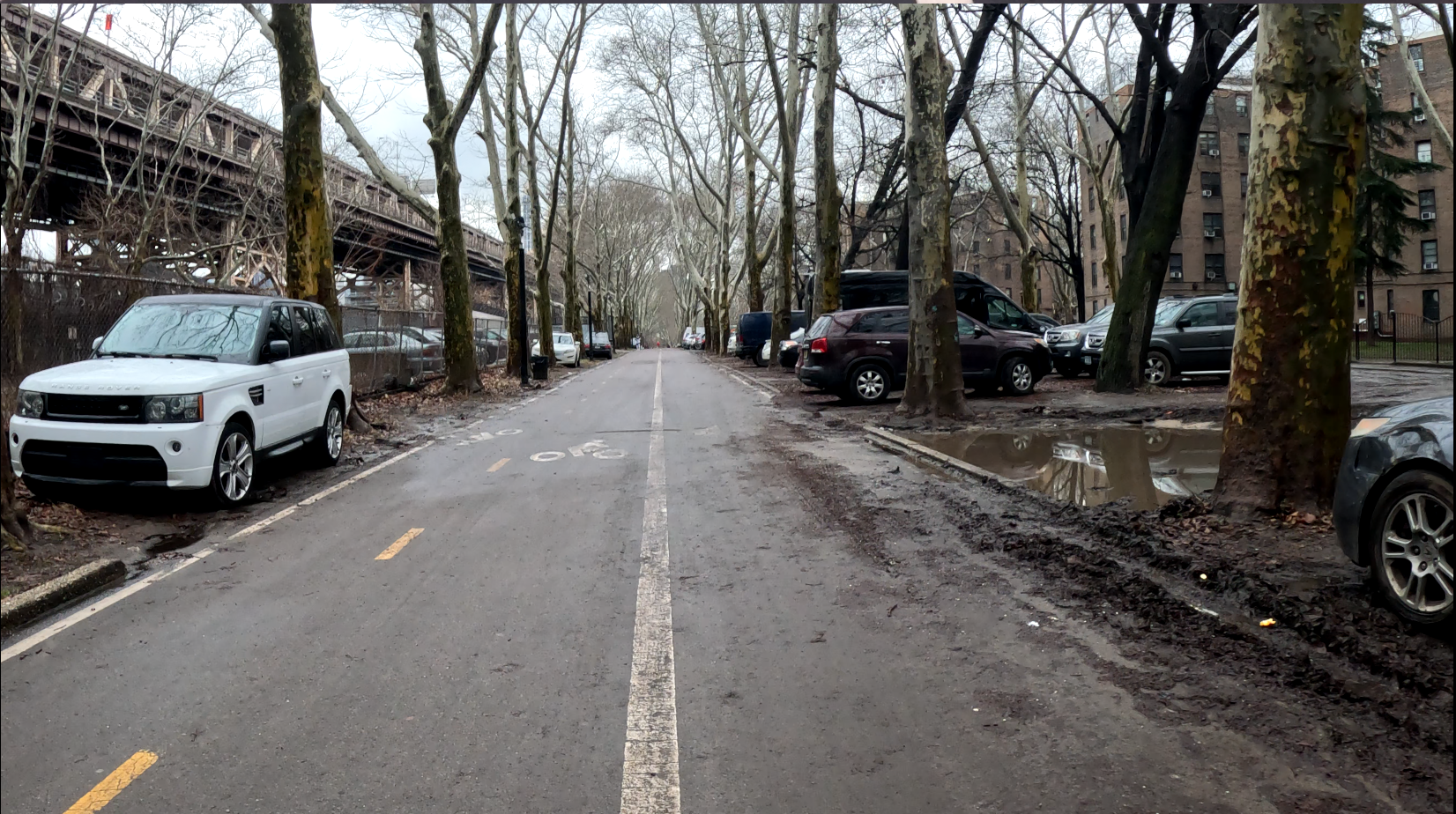By law, the removal of even small amounts of parking spaces in New York City is a complicated and lengthy process, often involving multiple rounds of community input, presentations before community boards, and city officials withstanding angry accusations from citizens. But creating spots, and stealing them from public green space, no less — that can be done by anybody on a whim, and the police tasked with stopping it will participate.
The latest, and perhaps most egregious example of this is a rapidly deteriorating situation in Long Island City, where locals and city officials have reappropriated enough land for storing nearly 100 vehicles on a greenway segment alongside the Queensbridge Houses. What once was a lush urban forest and green space to improve the quality of life of NYCHA residents has been reduced to the aesthetic appeal of a Walmart parking lot.
This is possible because the segment is unprotected by bollards. The only deterrent is the discretion of the police to enforce it. And despite widespread community urging, the police have shown no interest in enforcement.
Besides the loss of public space for pedestrians, cyclists, joggers, dog-walkers, and others, the environmental loss might already be severe.
The cars are parked between London Plane trees, a hearty urban beauty similar to the American Sycamore. They are tough trees that live hundreds of years and grow to properly New York skyscraping heights even in unforgiving human environments — but they are not indestructible. No tree can survive without its roots, and no root systems can survive while being constantly compacted by thousands of pounds of glass and steel. Eventually they will suffocate and die.
The greenway from 21st St. to Vernon Blvd in Queens used to be one of my favorite bike paths in the city. Here's a photo I took riding it in 2018. Now it looks like this. @CMJulieWon, @NYC_DOT, @NYCParks and @NYPD114Pct - how did it get to this? pic.twitter.com/w5WllFm58n
— John Surico (@JohnSurico) March 26, 2024
What happens after that is anybody’s guess. As anyone who has felled a tree can attest, our arboreal friends are a lot bulkier on the ground than they appear when soaring into the sky. Even a modest tree contains a shocking amount of wood, sawdust, and a labyrinth of branches. Taking down one sick or dying tree is an undertaking, removing one-third of a mile of greenway with scores of 100-foot tall London Planes and reseeding the area is a military operation.
Occasionally people who defend this practice of parking on the greenway try to use the residents of the adjacent public housing complex as a scapegoat for why this practice should be allowed (as if the disadvantaged citizens living in public housing are the ones parking Ranger Rovers on the greenway, instead of being abused by those that do). It goes without saying that even if this were true, the disruption to those living in the Queensbridge Houses during such a rehabilitation project would be significantly more harmful than the inconvenience of making a tiny fraction of residents find legal parking spots.
Part of the reason this tragedy has been allowed to persist is that everyone, including the police, have their pet theories on whom the cars belong to. Social media posts on this issue that have dominated the New York City online ecosystem in recent days have generated over a thousand comments, many offering up villains or alternatively, sympathetic parties the law should turn a blind eye to. NYCHA residents, NYCHA workers (the cop’s theory), construction workers for the nearby Queensboro bridge rehabilitation, wealthy LIC residents, migrants, police officers, suburbanites parking then taking the train — all have been shamed. In reality, it is probably a mix of parties, but what is rarely addressed is why this matters: Who owns the Escalade that is parked on the tree’s root system, and how sympathetic their life is, are completely irrelevant facts to the tree or the law.
Surprisingly, the law does not agree with this assessment. At the NYPD 114th Precinct Community Council meetings, residents have been urging the department to take action against the lawlessness on the greenway for months. Like so many other issues that involve crimes and misdemeanors involving cars, the officers prefer to let the vehicle owners run rampant. When confronted about the lack of enforcement at the most recent meeting, they passed the blame to Public Service Area 9 officers, (a branch of their own department). And officers claimed their department had been in contact with the Parks Department, which plans to install physical barriers along the corridor to physically prevent drivers from parking on the green space. There is no timeline for this work.
Preventative measures would undoubtedly be an improvement, but it is unclear why this sort of interdepartmental warfare — where one city agency has to go to extreme and costly measures to address the corruption and laziness of another — can not be sorted out by their boss, the mayor. For an administration obsessed with projecting strength, the weaknesses inherent in not being able to align administrative agencies is rather telling.
Nick Gulotta, Chief of Staff for Council Member Julie Won, confirmed that Won asked NYPD for enforcement multiple times, with no success.
“Council Member Won fully supports the call for the Parks Department to install fencing and bollards to prevent cars from illegally parking and driving through the Queensbridge Baby Park Greenway," he added. "She has called for this multiple times. The Parks Department has informed our office that they are working on a 'barricade plan' with NYCHA."
Until then, the environment degrades outside the homes of already disadvantaged citizens the mayor claims to serve, the trees continue to die, and the community loses a little more faith in government’s ability to perform routine tasks.






